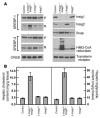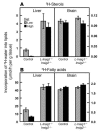Schoenheimer effect explained--feedback regulation of cholesterol synthesis in mice mediated by Insig proteins
- PMID: 16100574
- PMCID: PMC1184040
- DOI: 10.1172/JCI25614
Schoenheimer effect explained--feedback regulation of cholesterol synthesis in mice mediated by Insig proteins
Abstract
End-product feedback inhibition of cholesterol synthesis was first demonstrated in living animals by Schoenheimer 72 years ago. Current studies define Insig proteins as essential elements of this feedback system in mouse liver. In cultured cells, Insig proteins are required for sterol-mediated inhibition of the processing of sterol regulatory element-binding proteins (SREBPs) to their nuclear forms. We produced mice with germline disruption of the Insig2 gene and Cre-mediated disruption of the Insig1 gene in liver. On a chow diet, these double-knockout mice overaccumulated cholesterol and triglycerides in liver. Despite this accumulation, levels of nuclear SREBPs and mRNAs for SREBP target genes in lipogenic pathways were not reduced. Whereas cholesterol feeding reduced nuclear SREBPs and lipogenic mRNAs in wild-type mice, this feedback response was severely blunted in the double-knockout mice, and synthesis of cholesterol and fatty acids was not repressed. The amount of HMG-CoA reductase protein was elevated out of proportion to the mRNA in the double-knockout mice, apparently owing to the failure of cholesterol to accelerate degradation of the enzyme. These studies indicate that the essential elements of the regulatory pathway for lipid synthesis function in liver as they do in cultured cells.
Figures






Similar articles
-
Insig proteins mediate feedback inhibition of cholesterol synthesis in the intestine.J Biol Chem. 2014 Jan 24;289(4):2148-56. doi: 10.1074/jbc.M113.524041. Epub 2013 Dec 11. J Biol Chem. 2014. PMID: 24337570 Free PMC article.
-
Overexpression of Insig-1 in the livers of transgenic mice inhibits SREBP processing and reduces insulin-stimulated lipogenesis.J Clin Invest. 2004 Apr;113(8):1168-75. doi: 10.1172/JCI20978. J Clin Invest. 2004. PMID: 15085196 Free PMC article.
-
Sterol-regulated ubiquitination and degradation of Insig-1 creates a convergent mechanism for feedback control of cholesterol synthesis and uptake.Cell Metab. 2006 Jan;3(1):15-24. doi: 10.1016/j.cmet.2005.11.014. Cell Metab. 2006. PMID: 16399501
-
Sterol metabolism and SREBP activation.Arch Biochem Biophys. 2010 Sep 15;501(2):177-81. doi: 10.1016/j.abb.2010.06.004. Epub 2010 Jun 10. Arch Biochem Biophys. 2010. PMID: 20541520 Review.
-
Regulation of cholesterol and fatty acid synthesis.Cold Spring Harb Perspect Biol. 2011 Jul 1;3(7):a004754. doi: 10.1101/cshperspect.a004754. Cold Spring Harb Perspect Biol. 2011. PMID: 21504873 Free PMC article. Review.
Cited by
-
CD36-deficient congenic strains show improved glucose tolerance and distinct shifts in metabolic and transcriptomic profiles.Heredity (Edinb). 2012 Jul;109(1):63-70. doi: 10.1038/hdy.2012.14. Epub 2012 Apr 4. Heredity (Edinb). 2012. PMID: 22473311 Free PMC article.
-
Haploid genetic screens identify SPRING/C12ORF49 as a determinant of SREBP signaling and cholesterol metabolism.Nat Commun. 2020 Feb 28;11(1):1128. doi: 10.1038/s41467-020-14811-1. Nat Commun. 2020. PMID: 32111832 Free PMC article.
-
Obesity resistant mechanisms in the Lean polygenic mouse model as indicated by liver transcriptome and expression of selected genes in skeletal muscle.BMC Genomics. 2011 Feb 3;12:96. doi: 10.1186/1471-2164-12-96. BMC Genomics. 2011. PMID: 21291556 Free PMC article.
-
Cholesterol feedback: from Schoenheimer's bottle to Scap's MELADL.J Lipid Res. 2009 Apr;50 Suppl(Suppl):S15-27. doi: 10.1194/jlr.R800054-JLR200. Epub 2008 Oct 29. J Lipid Res. 2009. PMID: 18974038 Free PMC article. Review.
-
Hyperpolarized 13C Spectroscopic Evaluation of Oxidative Stress in a Rodent Model of Steatohepatitis.Sci Rep. 2017 Apr 20;7:46014. doi: 10.1038/srep46014. Sci Rep. 2017. PMID: 28425467 Free PMC article.
References
-
- Schoenheimer R, Breusch F. Synthesis and destruction of cholesterol in the organism. J. Biol. Chem. 1933;103:439–448.
-
- Gould RG. Lipid metabolism and atherosclerosis. Am. J. Med. 1951;11:209–227. - PubMed
-
- Gould RG, Taylor CB, Hagerman JS, Warner I, Campbell DJ. Cholesterol metabolism. I. Effect of dietary cholesterol on the synthesis of cholesterol in dog tissue in vitro. J. Biol. Chem. 1953;201:519–523. - PubMed
-
- Brown MS, Goldstein JL. Multivalent feedback regulation of HMG CoA reductase, a control mechanism coordinating isoprenoid synthesis and cell growth. J. Lipid Res. 1980;21:505–517. - PubMed
-
- Brown MS, Goldstein JL. The SREBP pathway: regulation of cholesterol metabolism by proteolysis of a membrane-bound transcription factor [review] Cell. 1997;89:331–340. - PubMed
Publication types
MeSH terms
Substances
Grants and funding
LinkOut - more resources
Full Text Sources
Other Literature Sources
Medical
Molecular Biology Databases
Research Materials

